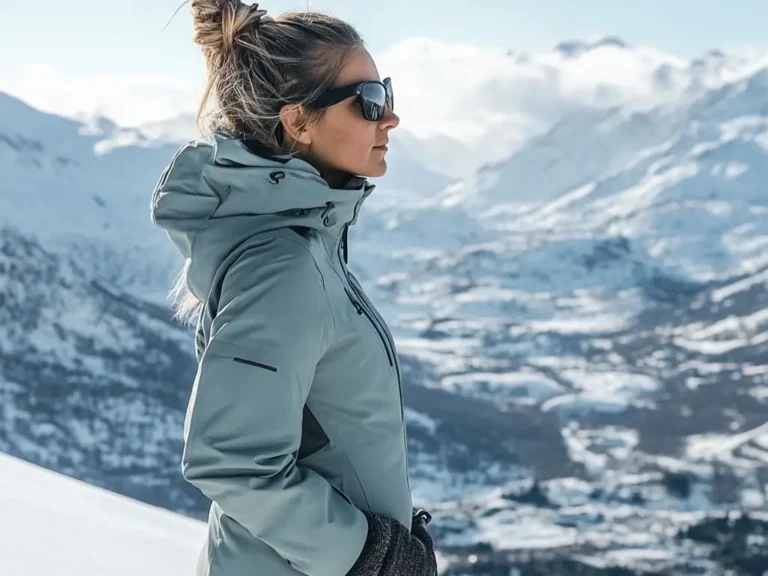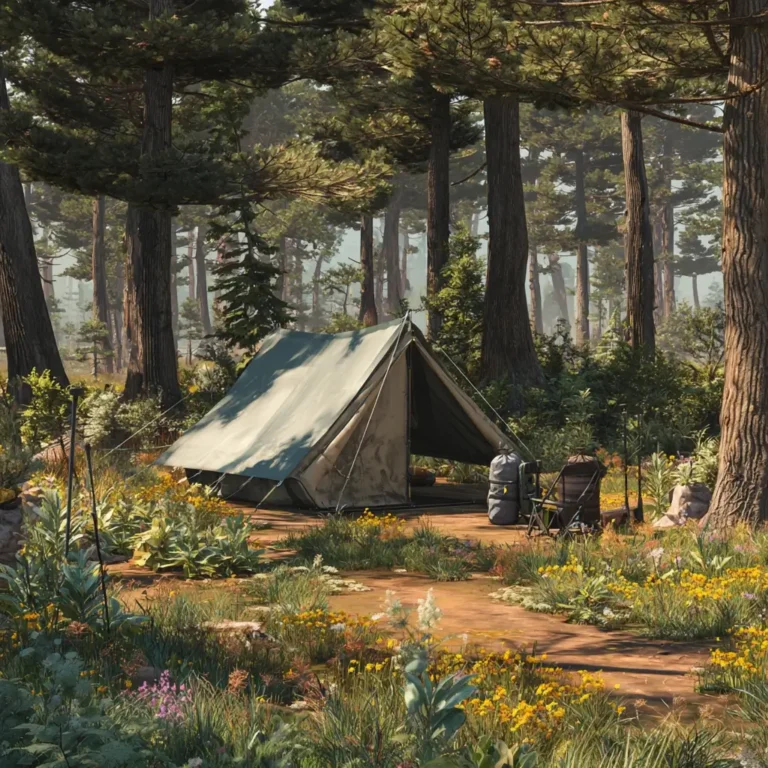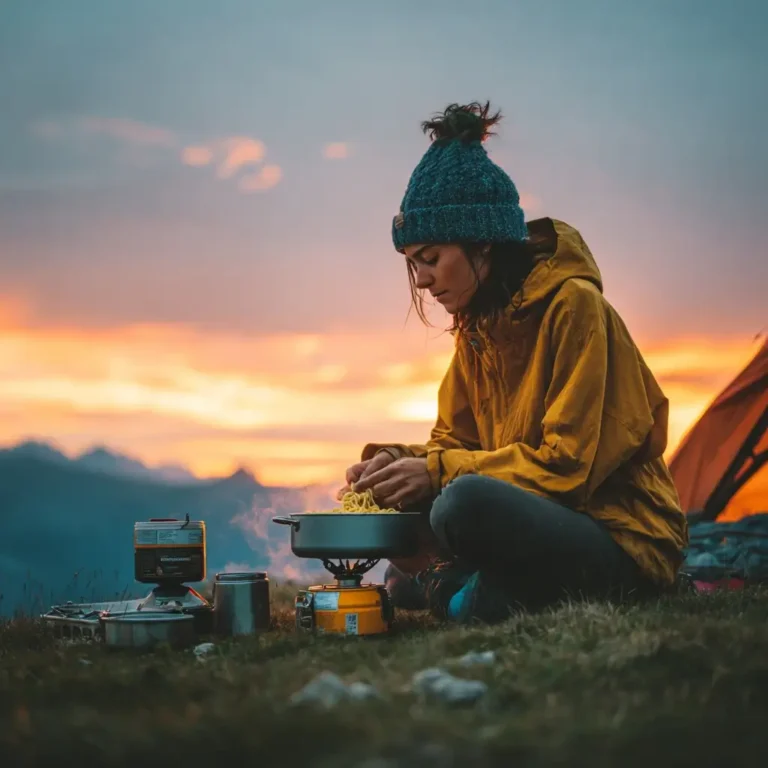How to Use This Guide 👋
We’ve logged thousands of trail miles and just as many campsite nights, so we know the difference between a dialed-in duffel and a chaotic gear explosion – camping packing list. This mega-guide delivers every tip, trick, and checklist you need to pack smarter, travel lighter, and roll into camp feeling like champs.
And here’s the best part: at the end of the article you’ll find a free, printable camping packing list ready to download.
Affiliate Disclosure: We’re part of the Amazon Services LLC Associates Program. If you click a product link and buy something, we may earn a small commission—at no extra cost to you—which helps keep the coffee (and the campfire) brewing here at Advntur! 🔥
Section 1 – The “Big Three” Mind-Set: Shelter, Sleep & Cook 🏕️

Before we throw small stuff into totes, let’s nail our primary mission-critical categories. When we pack around the “Big Three,” nothing important gets left behind.
- Shelter: Tent, stakes, guylines, footprint.
- Sleep System: Sleeping bag, pad, pillow, optional liner.
- Cook System: Stove or fire gear, fuel, lighter/matches, cookware, utensils.
Everything else—clothes, gadgets, games—must orbit these essentials. If space runs out, we ditch luxury items, not the Big Three.
Pro Gear Pick: The Kelty Discovery 4-Person Tent is a quick-pitch dome that weighs under 10 lb and costs less than many two-person rigs. ➜ Check price on Amazon
Section 2 – Master Packing List, Item by Item 📋

Below is our master list divided into logical groups. Copy it to your notes app or print it; we’ve left little check-boxes you can mark by hand.
Shelter & Sleep
Full List of Shelter and Sleeping Essentials
- Tent or tarp system
- Footprint or groundsheet
- Stakes + 2 spare
- Paracord/extra guylines
- Hammer or stake mallet
- Sleeping bag (temperature-rated)
- Sleeping pad (inflatable or foam)
- Camp pillow or stuff-sack pillow
Cooking & Food Storage
Full List of Cooking and Food Storage Essentials
- Stove + appropriate fuel
- Lighter + stormproof matches
- Cook pot/fry pan
- Spatula, spoon, tongs
- Bowls/plates + cutlery
- Insulated mugs
- Cutting board + knife
- Biodegradable soap + sponge
- Cooler + ice blocks
- Bear canister or hang kit (where required)
Hydration & Water Treatment
Full List of Hydration and Water Treatment Essentials
- Water bottles or reservoir (2–4 L capacity)
- Backup collapsible jug
- Filter, purifier, or tablets
Favorite Filter: We adore the Sawyer Squeeze Water Filter; it weighs 3 oz, screws on standard bottles, and filters 100,000 gallons. ➜ See on Amazon
Lighting & Power
Full List of Lighting & Power Essentials
- Headlamp + spare batteries
- Lantern or string lights
- Power bank (10,000 mAh+)
- Charge cables
Tools & Safety
Full List of Tools & Safety Essentials
- Multitool
- Duct tape wrap (around water bottle)
- Mini sewing kit
- First-aid kit
- Whistle + mirror
- Map + compass/GPS
- Knife or hatchet (if allowed)
- Fire starters/tinder
Clothing (3-Season Baseline)
Full List of Clothing Essentials
- Base: moisture-wicking tee & underwear (2–3 each)
- Mid: fleece, puffy, or wool sweater
- Outer: waterproof jacket, rain pants
- Bottoms: hiking pants or shorts (2 pairs)
- Feet: wool socks (3–4 pairs)
- Head/Hands: beanie, sun hat, lightweight gloves
- Camp shoes or sandals
Toiletries & Personal Care
Full List of Toiletries and Personal Care Essentials
- Toothbrush/paste
- Quick-dry towel
- Wet wipes & hand sanitizer
- Reef-safe sunscreen
- Bug spray
- Lip balm w/ SPF
- Prescription meds + copies
- Glasses/contacts supplies
Camp Comfort & Fun
Full List of Camp Comfort and Fun Essentials
- Camp chairs
- Hammock + straps
- Packable blanket
- Cards or dice
- Binoculars
- Star map app
Top Chair Pick: The Helinox Chair Zero folds to the size of a water bottle and holds 265 lb. We never leave home without it. ➜ View on Amazon
Section 3 – Seasonal Tweaks: Summer Sizzle to Winter Whiteouts ☀️🍂❄️

Summer (June–August)
We swap 20 °F bags for 40 °F quilts, carry a mesh tent, and throw in extra electrolytes. Pack a REI Co-op Sahara buff for bug clouds and sunburn prevention.
Shoulder Season (March–May, Sept–Oct)
We bump sleeping bag rating down to 20 °F, add mid-weight base layers, and pack packable down booties. A Sea to Summit Reactor liner adds 15 °F warmth for 8 oz.
Winter & High-Alpine
Four-season tents, closed-cell foam under inflatable pads, -10 °F bags, shovel, avalanche beacon for snow zones, plus double fuel (canister stoves sputter below 20 °F—white-gas rules).
Cold-Weather Hero: The MSR WhisperLite Universal Stove burns white gas, kerosene, or canister fuel—perfect for freezing temps. ➜ Amazon link
Section 4 – The Tetris Method: Packing to Maximize Space 🧩

We treat packing like a real-life video game:
- Stage Everything: Lay gear on a tarp before loading. Seeing it all exposes redundancies.
- Group by “Access Speed.” Items needed en route (snacks, raincoat, maps) live atop or in side pockets; “camp only” items sit deeper.
- Compress Soft Goods. Use compression sacks for sleeping bags and puffy jackets—squish until the air whooshes out.
- Fill Dead Space. Slide utensils or tent poles down backpack sides; stuff socks inside cook pots.
- Balance Weight. Heavy items (food, water) ride close to your spine, mid-back. Shoulder and hip comfort skyrocket.
Car-camping or van-life? We load in crates labeled COOK, SLEEP, CLOTHES, FUN. Clear labels mean we find the headlamp before dark—not after.
Section 5 – Food & Kitchen Strategy: Eat Like Trail Royalty 🍳

Building the Menu
We aim for 2,500–3,000 calories per person daily on moderate hikes. Our formula:
- Breakfast 25 % – oatmeal, bagels, or breakfast burritos
- Lunch 25 % – tortillas + tuna/hummus, trail mix, dried fruit
- Dinner 40 % – one-pot pastas, chili, ramen-boost bowls
- Snacks 10 % – jerky, energy bars, gummies
Storage Tips
- Freeze meat flat so it acts as a cooler ice pack the first day.
- Label each meal in zip bags; grab-and-go reduces rummaging.
- Hang or locker food in bear country—no exceptions.
Fuel Saver: The Jetboil Flash boils 2 cups in 100 seconds using half the fuel of many stoves. ➜ Grab on Amazon
Spice Kit Hack
We carry a stackable Go-Tube spice tower: salt/pepper, garlic powder, red pepper flakes, cinnamon. Flavors skyrocket; weight barely rises.
Section 6 – Health & Safety: First-Aid Essentials and Emergency Prep ⛑️

When something goes sideways, packed know-how trumps panic.
Baseline First-Aid Checklist
- Adhesive bandages assorted sizes
- Blister pads (moleskin or hydrocolloid)
- Gauze pads + medical tape
- Triple-antibiotic ointment
- Ibuprofen & antihistamines
- Tweezers + safety pins
- Elastic wrap for sprains
- CPR face shield
- Emergency blanket
- Tick key or card
- Quick-reference first-aid guide
Pro Kit Pick: The Adventure Medical Kits Mountain Series Hiker covers two people for four days and still slides into the lid pocket. ➜ See details
Emergency Electronics
- Satellite messenger (Garmin InReach Mini 2)
- Whistle (attached to backpack strap)
- Power bank + solar panel in shoulder seasons
Documentation
Photocopy driver’s license, insurance card, and emergency contacts; stash in a Ziploc near first-aid kit. We hope you never need it, but you’ll be a logistical wizard if you do.
Section 7 – Leave No Trace & Gear Maintenance 🌎
Packing out what we pack in isn’t just polite—it’s preservation.
- Trash & Microtrash: Line a dry-bag with a plastic bag; stash wrappers and food scraps.
- Greywater: Scatter at least 200 ft from water sources.
- Toilet Protocol: Trowel a 6–8″ cathole, pack out TP in a separate sealable bag.
- Gear Clean-Up: Shake dirt off tents before storage, wipe cook kits with biodegradable soap, dry everything 100 % to avoid mildew.
Eco Upgrade: The Sea to Summit Pocket Towel folds flat and weighs less than 3 oz. ➜ Amazon listing
Annual maintenance—seam-seal tents, re-DWR jackets, sharpen knives—keeps our gear out of landfills and our wallets happy.
Section 8 – Final Pre-Trip Checklist & Departure Ritual 🚀

24 Hours Out
- Charge power banks & headlamps
- Pre-cool the cooler with a sacrificial ice bag
- Download offline maps & weather forecast
- Re-check permit printouts
- Tell a friend the route + return time
1 Hour Out
- Fill water reservoirs
- Load refrigerated food last
- Do a driveway “pocket tap”: phone, wallet, keys, ID, sunglasses.
- Crank the road-trip playlist—we recommend classic rock for instant adventure vibes.
The Send-Off Toast
We always clink insulated tumblers and shout, “See you where the cell signal ends!” That tiny ritual sparks excitement and reminds us why we camp: to swap asphalt for pine duff, fluorescent lights for full moons, notifications for wood-smoke crackles.
Our Experience with camping packing list
Last July, we discovered the magic of a truly dialed-in camping packing list, and the difference it made still blows our minds. Instead of the usual frantic scramble—mismatched socks, missing tent stakes, and a cooler that somehow swallowed the headlamp—we spread every item out on the garage floor, ticked through our master checklist, and watched chaos morph into confidence. The Big Three came first: shelter, sleep, cook. Then we layered in clothing by climate, squirreling socks inside cookware and rolling shirts into pot voids like backcountry Tetris masters. A neon-taped dry bag became our mobile pantry; a Zip-locked first-aid kit slid into the lid pocket where we could grab it blindfolded. On trip day we loaded color-coded crates—COOK, SLEEP, MISC—into the Subaru, closed the hatch, and felt a collective exhale ripple through the crew. Five hours later, when dusk settled over Yosemite Valley, setup was pure poetry: tent pitched in seven minutes, stove roaring in ten, headlamps located on the first reach. We toasted marshmallows to the sweet, smug taste of preparation and swore never again to wing it. That single sheet of paper turned stress into freedom and upgraded campfire stories for good. We can’t wait to pack again.
Our tips for a camping packing list
- Start with the “Big Three.” List shelter, sleep system, and cook kit first; everything else orbits these mission-critical items.
- Lay It All Out. Spread gear on a tarp or garage floor before loading—seeing duplicates (three spatulas?!) saves space and sanity.
- Color-Code & Label. Stash kitchen, sleep, and clothes in different-colored dry bags or crates so you can grab the right bin in the dark.
- Pack by Access Speed. Items needed on the road (snacks, rain jacket) ride on top; “camp-only” gear burrows deeper in the pack or trunk.
- Compress Soft Goods. Use stuff sacks or roll-top dry bags to shrink sleeping bags, quilts, and puffy jackets—hello, extra cooler room!
- Fill Dead Space. Slide tent poles down pack sides and stuff socks inside cookware; every hollow spot is free storage real estate.
- Double-Check Fuel & Batteries. Weigh stove canisters, recharge power banks, and toss spare AAAs in a zip bag taped to the headlamp.
- Water Wins Trips. Carry at least 4 L per person or bring a proven filter—hydration mishaps ruin morale faster than forgotten s’mores.
- Print + Digital Lists. Keep a laminated checklist with a dry-erase marker in your gear tote and a duplicate in your phone’s notes app.
- Post-Trip Audit. After every adventure, jot what stayed unused or went missing; update the master list so next time is even smoother.
FAQ – Camping Packing List
What are the 10 essentials in camping?
The classic “10 Essentials” list includes navigation (map + compass or GPS), sun protection, insulation (extra layers), illumination (headlamp + batteries), first-aid kit, fire-starting tools, repair kit / multi-tool, shelter (emergency bivy or tarp, even if you carry a tent), nutrition (extra day’s food), and hydration (water + treatment). Together they cover the survival basics of staying found, warm, dry, fed, and safe.
What to take on a camping packing list?
Start with the Big Three—tent (and footprint), sleep system (bag, pad, pillow), and cook setup (stove, fuel, cookware). Add weather-appropriate clothing, food and water supplies, lighting, hygiene items, first-aid, tools, and comfort extras like camp chairs or games, tailoring quantities to trip length, season, and group size.
What is the most forgotten item when camping?
Spare headlamp batteries (or the headlamp itself) top the “most-forgotten” charts, followed closely by tent stakes and a lighter. Because they’re small and often packed last, they’re easy to overlook yet painfully missed once darkness or dinner time arrives.
Last Word – camping packing list 🎇
We just speed-ran everything from Big-Three basics to gourmet camp kitchen hacks, first-aid failsafes, and space-saving wizardry tested wisdom. With this packing list you can step away from the screen, shoulder your bag, and launch into the wild feeling prepared, light, and fired up.
Grab your free, printable checklist now—click below to download the Camping Packing List and hit the road fully prepared!
So print it, share it, and tweak it until it fits your crew. Then let’s meet out there—where the only thing better than the view is the feeling of digging through an impeccably packed tote and finding exactly what you need, exactly when you need it. Happy packing, and even happier adventuring!
If you enjoyed this post, you might also love our article on Find Your Perfect Camping Tent: Top Picks & Tips! for the perfect Camping Tent in 2025.
If you enjoyed this blog post about our camping packing list, we’d love to hear from you! Leave a comment below and share your favorite winter hiking looks or tips.




